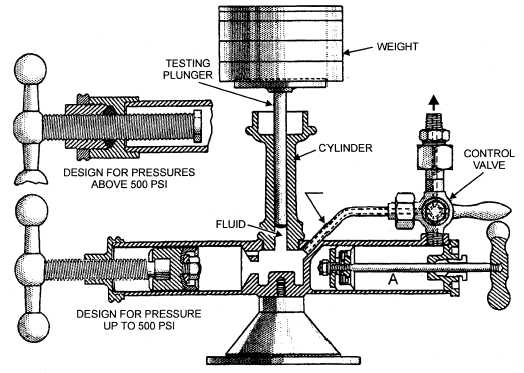2. Have the gauges well lighted to make the correct reading easier to take.
3. Keep the covers tight, and replace broken glass promptly.
4. Protect the gauges as far as possible from vibration, excessive temperatures, corrosive liquids, and rapid changes in pressure.
TESTING
Whenever you believe that a gauge is not accurate, test it with a deadweight tester. Figure 5-55 shows such a tester. In this testing device, the gauge under test is subjected to pressure by applying weights to a plunger. The plunger is accurately fitted into a vertical cylinder that contains a water-base hydraulic fluid.
WARNING
Mineral oil or other petroleum products must NEVER be used in the deadweight pressure gauge tester.
Weights are applied to the plunger, and the pressure is transmitted to the fluid and then to the gauge by way of transmission piping and a control valve. The plunger itself exerts a known pressure of approximately 5 psi. Additional weights are provided in sizes that exert pressures equal to 5, 10, and 20 psi.
In figure 5-55, notice that there are two horizontal cylinders and a main vertical cylinder. The plunger in cylinder A pumps hydraulic fluid into the instrument when it is first filled. The plunger in cylinder B exerts enough force on the fluid so the testing plunger maintains the weight platform in position about 2 inches above the top of the vertical cylinder. At the beginning of the test, the plunger in cylinder B should be screwed out as far as it will go, so cylinder B (as well as the main cylinder) fills with fluid. If the weighted test plunger is pushed too far down at anytime during the test, the plunger in cylinder B should be screwed in as far as necessary to force the test plunger up so it will have freedom of movement.
To test a pressure gauge in the deadweight tester, connect the gauge to the apparatus and fill the tester with the proper water-base hydraulic fluid, if necessary. (Some testers of this type are designed to be kept full of fluid at all times, but others require filling before each use.) Then level the tester. Apply weights to the testing plunger, as required, and check the pressure gauge readings for accuracy. The plunger should be gently rotated, as each weight is added, to ensure its freedom of movement. If the gauge reading increases by the proper amount as each weight is added

Figure 5-55. - Deadweight pressure gauge testing apparatus.
Continue Reading